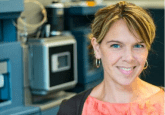2016 New Investigator: Egan Doeven


Nominee:
Nominated By:
Supporting Comments:
What made you choose a career in bioanalysis?
Complex biological systems rely on so many unique and highly specific chemical and biological recognition events, which is a rich source of inspiration for bioanalytical research. Harnessing these processes is the key to the development of sensors and bioanalytical techniques to not only understand these complex systems, but also create new technologies for the diagnosis, monitoring and treatment of disease in humans and animals. The multidisciplinary nature of bioanalytical research allows me to pursue, apply and draw together my expertise and interests in analytical chemistry, electrochemistry, spectroscopy, biotechnology, interfacial science, 3D printing and low-cost manufacturing/prototyping techniques.
Describe the main highlights of your bioanalytical research, and its importance to the bioanalytical community.
The most significant contribution to date is a fundamentally new approach to electrochemiluminescence (ECL). ECL detection, which involves measuring the light emitted from electrochemically excited ‘labels’, is used extensively in binding assays for clinical diagnostics, life science research and biodefence. However, current commercial ECL technologies involve labels based on only one luminescent metal complex that emits orange light.
Multicolor ECL for rapid multi-analyte quantification has long been sought in the field, but its development has been inhibited by the dearth of complexes exhibiting high ECL efficiency and the difficulty in distinguishing their broad emission bands.
My breakthroughs began with a simple idea: selective detection of multiple ECL labels could be derived not only from their distinct emission color, but also the distinct oxidation potentials required for their excitation. This provided a new platform for rapid, simultaneous, multiplexed ECL detection for affinity binding assays.
My subsequent proof-of-concept experiments have explored the application of these detection systems in low-cost microfluidic devices operated with smartphones, where the USB output is used to control the excitation and the in-built camera serves as the photodetector. I am now exploiting these advances in the development of at-scene devices for avian influenza detection and subtyping.
What is the impact of your work beyond your home laboratory?
My papers on this approach to ECL detection (published 2012–2016) have received over 200 citations and in 2015 I was invited to prepare the first review of multiplexed potential-resolved ECL detection (Doeven EH, Barbante GJ, Hogan CF, Francis PS. Potential-resolved electrogenerated chemiluminescence for the selective detection of multiple luminophores. ChemPlusChem doi:10.1002/cplu.201580361 (2015).). This new approach to detection has attracted considerable industry funding and I am now working with an Australian manufacturing company (Romar Engineering) on the development of devices for at-scene detection of disease in the livestock industry. These devices incorporate multiplexed ECL-based assays on low-cost microfluidic devices controlled by readily available consumer technology.
PhD student Emily Kerr (whom I supervise in collaboration with Prof Francis) was recently awarded a prestigious Endeavor Scholarship by the Australian Government to undertake the final year of her PhD in the laboratories of Professor George Whitesides at Harvard University (MA, USA), to implement the new multiplexed ECL detection systems into their paper-based microfluidic and other low-cost, portable, bioanalytical platforms.
Describe the most difficult challenge you have encountered in the laboratory and how you overcame it.
The most difficult aspect of the development of multicolor multiplexed ECL detection has been to understand and overcome the complex, competing excitation pathways and the energy- and electron-transfer routes between concomitant ECL labels. This has required a multifaceted approach, including a re-examination of the chemical energy requirements of ‘co-reactant’ ECL under the new context of multicolor ECL systems (Kerr E, Doeven EH, Wilson DJ, Hogan CF, Francis PS. Considering the chemical energy requirements of the tri-n-propylamine co-reactant pathways for the judicious design of new electrogenerated chemiluminescence detection systems. Analyst 141, 62–69 (2016).). To support this, the energy- and electron-transfer pathways were examined under ‘annihilation’ ECL conditions, to remove the complicated contributions from the oxidation of the co-reactant and isolate the interactions between specific ECL labels (e.g., Kerr E, Doeven EH, Barbante GJ et al. Annihilation electrogenerated chemiluminescence of mixed metal chelates in solution: modulating emission colour by manipulating the energetic. Chem. Sci. 6, 472–479 (2015); Kerr E, Doeven EH, Barbante GJ et al. New perspectives on the annihilation electrogenerated chemiluminescence of mixed metal complexes in solution. Chem. Sci. doi:10.1039/C6SC01570K (2016) (Epub ahead of print)).
The new knowledge derived from these fundamental studies is now being applied under assay conditions, in which the derivatized labels are bound to biomolecules upon magnetic-microparticle supports. The deleterious effects of interlabel electron-transfer and energy-transfer can be thus be overcome through (i) the judicious selection of label and ‘co-reactant’ properties, (ii) the shift in dominant reaction pathways when the labels are bioconjugated on microparticle supports and away from the electrode used to initiate detection, (iii) coupling with spatial resolution and/or (iv) multivariate data analysis, which can be incorporated into the control ‘App’ on the smartphone.
Describe your role in bioanalytical communities/groups.
To meet the many challenges of this bioanalytical research, I have worked with and coordinated a network of researchers across numerous disciplines at several Australian institutions, including Deakin University, La Trobe University, and The University of Melbourne. This has included synthetic chemists (to prepare the purpose-designed ECL-labels), electrochemists, physical chemists and computational chemists (for the exploration of the energy requirements and interactions within the multiplexed ECL systems), engineers (involved in the fabrication of microfluidic devices) and molecular biologists (for the bioconjugation of labels and application in various assays). One of the more surprising collaborations has been with a Professor of Ecology, whose experience in experimental techniques and interpretation of data on the biophysics of light and color vision in animals has been a valuable resource in the development of new approaches to discriminate the combined multicolor emissions of the multiplexed ECL systems, particularly in the exploitation of the red-green-blue data capture of a conventional digital cameras for this purpose (as discussed in paper #4 below).
Moreover, I have communicated my findings to the wider scientific communities through my own presentations and those of PhD students under my supervision at conferences, such as the International Meeting on Electrogenerated Chemiluminescence (Italy, 7–10 September 2014), 18th International Symposium on Bioluminescence and Chemiluminescence (Sweden, 23–28 June 2014), and the 7th Australia and New Zealand Nano-Microfluidics Symposium (Brisbane, Australia, 21–23 March 2016).
Please list up to five of your publications in the field of bioanalysis:
- Doeven EH, Zammit EM, Barbante GJ, Hogan CF, Barnett NW and Francis PS. Selective excitation of concomitant electrochemiluminophores: tuning emission color via electrode potential. Angewandte Chemie International Edition 51, 4354–4357 (2012).
- Delaney JL, Doeven EH, Harsant AJ, Hogan CF. Use of a mobile phone for potentiostatic control with low cost paper-based microfluidic sensors. Analytica Chimica Acta 790, 56–60 (2013).
- Doeven EH, Zammit EM, Barbante GJ, Francis PS, Barnett NW and Hogan CF. A potential-controlled switch on/off mechanism for selective excitation in mixed electrochemiluminescent systems. Chemical Science 4, 977–982 (2013).
- Doeven EH, Barbante GJ, Kerr E, Hogan CF, Endler JA, Francis PS. Red-green-blue electrogenerated chemiluminescence utilizing a digital camera as detector. Analytical Chemistry 86, 2727-2732 (2014).
- Doeven EH, Barbante GJ, Harsant AJ et al. Mobile phone-based electrochemiluminescence sensing exploiting the ‘USB On The-Go’ protocol. Sensors and Actuators B-Chemical 216, 608–613 (2015).
Please select one publication from above that best highlights your career to date in the field of bioanalysis and provide an explanation for your choice.
Publication #4. In this paper, the new concept of multicolor multiplexed ECL-detection (introduced in papers #1 and #3) was exploited for the first ECL system containing three metal-complex emitters (model labels). The labels were selectivity detected based on their distinct oxidation potentials and distinct emission colors, through two instrumental approaches:
- The first was designed for a laboratory setting, exploiting the automated operation of a potentiostat and miniaturized spectrometer to comprehensively resolve the three labels over the 3D ‘space’ of ECL intensity versus applied potential and emission wavelength.
- The second highlighted the utility of this approach for portable analytical devices. Detection was initiated using three voltages (which as shown in papers #2 and #5, can be applied using consumer technology such as smartphones) and for the first time, the ECL emission colour was discriminated exploiting the RGB data capture of a conventional digital camera.
These techniques, combined with the inherit selectivity of the immunoassay and related assays to which the labels can be applied, will provide selective multiplex sensing systems that can be operated with a smartphone, which also provides the facility to immediately send the results to a central laboratory, enabling truly portable bioanalytical systems, with myriad potential applications.
Find out more about this year’s New Investigator Award, the prize, the judging panel and the rest of our nominees.




